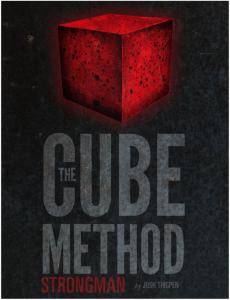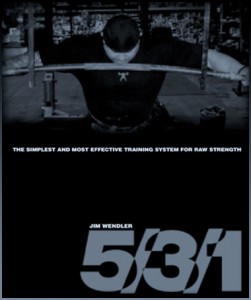If you’ve ever picked up a fitness magazine, you’ve probably come across a training plan used by some well-known and elite level athlete.
Naturally, our first instinct is to use it.
After all, if a top level athlete used the program – and got to where he/she is because of it (not always the case) – the program must be pretty good.
But often times, it doesn’t provide the results we were looking for, and the program that led to incredible gains for one person leads to complete garbage gains for us.
This isn’t because the program is necessarily bad (although there are definitely some bad ones out there) or the principles behind it aren’t sound.
It’s because each of us is unique (yep, we’re all special!), each of us has unique needs and goals, and each training plan needs to be individualized to fit our unique situation.
This is why – if you’re going to use a cookie-cutter program (hopefully a good one such as the Cube, 5/3/1, Sheiko, the Juggernaut Method, etc.) – it’s imperative that you DON’T run it exactly as written.
Often times it’s not the program itself that leads to subpar results, but the way that most people follow it (blindly and to a “T”).
Every program – no matter what it is – has the potential to elicit fantastic gains in performance.
You just have to know how to use it.
1. Figure out the Principles
This is the first – and most important step – when it comes to running a new training plan.
For the most part – and although each program has its differences – all successful training plans are founded on a few basic principles:
- Prioritize compound lifts
- Utilize some form of progression (linear, undulating, etc.)
- Try to set a new PR whenever possible (add weight to the bar, increase reps with a given weight, etc.)
- Spend a good amount of time building strength
- Keep things specific to the goal at hand
- Eliminate unnecessary work
- Choose accessory lifts that bring up weak points and help to build your main lifts
- Measure progress
That’s it!
That’s all there is to it!
Does each program vary in it’s progression scheme, rotation of exercises, total amount of volume and intensity, etc.?
Yes it does.
But the principles remain the same because at the end of the day, the principles are what make a training plan.
Not the smaller variables.
And once you understand this – once you can learn to separate the forest from the trees – you’ll make progress no matter how the finer details of the program are set up.
2. Individualize It
Once you figure out the principles behind the program, the next step is to individualize the specific variables to fit YOUR unique needs and goals.
If you’re following 5/3/1, why would you use the same exercises, volume, or training frequency as Jim Wendler?
You don’t have the same weaknesses as Jim Wendler.
You don’t have the same goals as Jim Wendler.
You haven’t had the same injuries as Jim Wendler.
You’re probably not as strong as Jim Wendler.
You’re probably not the same age as Jim Wendler.
You don’t have the same schedule as Jim Wendler.
YOU’RE NOT JIM WENDLER!
So why would it make sense for you to follow the program in the exact same fashion that he wrote it for HIMSELF?
The principles are solid, the progression scheme is solid, and you definitely don’t want to change things so much that it no longer resembles the program that you started with.
But, that doesn’t mean you shouldn’t change it at all.
That’s honestly what the creators’ of these programs WANT you to do.
And if you can find a balance between keeping the foundation of the program the same while still individualizing the smaller variables to fit YOUR needs and goals, you’ll get incredible results.
3. Don’t Program Hop
If I can stress anything in this article, it would be this:
Once you start a program, don’t jump ship for at least 3 months.
Program hopping was the reason I made almost zero progress for the first 2 years of my lifting career.
I would pick a program – let’s say 5/3/1 or the Cube – start following it, and if I couldn’t make my pecs dance like Terry Cruz come Sunday afternoon, well that program was obviously worthless and it was time to switch things up.
This mentality accomplished two things:
-it never gave the program I was on time to provide results, which prevented me from learning what worked and didn’t work, which ultimately hindered my long term progress
-it transformed me from a scrawny guy with no muscle in to an extremely irritated scrawny guy with no muscle.
It sucked.
And jumping programs – aside from increasing your psychological frustration – will get you absolutely nowhere.
As Strength Coach Eric Cressey put it, “a bad program followed consistently will yield better results than a great program followed sporadically.”
Stick with a program for at least 3 months.
If it doesn’t provide results by then, switch things up.
4. If It Ain’t Broke, Don’t Fix It
Finally, once you’ve started a program – and you’re getting great results from it – don’t change things just for the sake of changing them.
If you’re setting major PRs on the back squat, why would you change exercises simply because one training cycle ended and a new one is supposed to start?
If a certain rep range, training frequency, or overall form of progression is fun and currently working for you, why would you switch to something else?
I know variation and altering stimuli is important, but remember that “if it ain’t broke don’t, don’t fix it.”
Everyone has an estimate for the time frame it takes for your body to adapt to a specific protocol, but that’s honestly all it is – an estimate.
Your body will let you know when it has adapted to whatever you’re currently doing.
Don’t change anything until it does.
Like What You See?
Get the Smoot Fitness Guide to Getting Stronger - FREE.




Leave a Reply